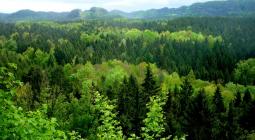The limits of forest carbon sequestration

Although nations are grappling with reducing carbon emissions to minimize climate change risks, they actually need to remove carbon dioxide from the atmosphere if the goal is to keep warming to less than 1.5°C (1). Although there has been substantial investment in technologies focusing on carbon capture, there is also interest in natural solutions, such as planting trees (2, 3). Trees remove CO2 from the atmosphere through photosynthesis, and forests sequester CO2 in the form of biomass and soil carbon. Though it seems logical that increased photosynthesis should lead to increased growth, multiple reports suggest that this is often not the case (4, 5). The interaction between photosynthesis, tree growth, and carbon sequestration has large implications for future carbon uptake and is a topic that remains widely debated. On page 758 of this issue, Cabon et al. (6) contribute to this debate by examining global photosynthesis estimates and tree ring measurements as a measure of growth.
JULIA K. GREEN AND TREVOR F. KEENAN | Science





